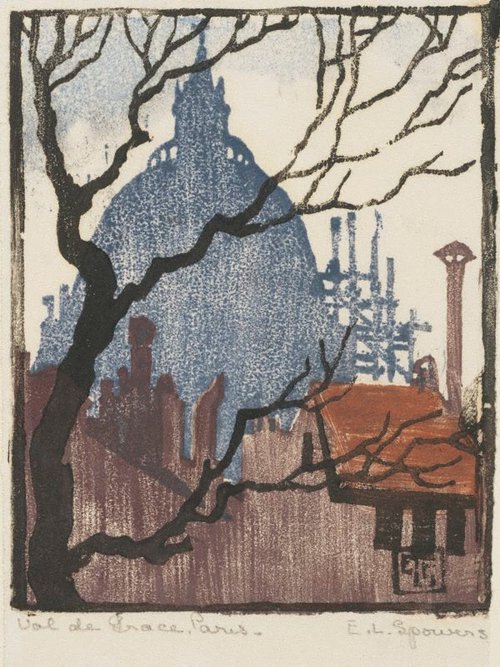-
Details
- Date
- 1928
- Media category
- Materials used
- linocut
- Edition
- 33/50
- Dimensions
- 17.3 x 26.4 cm blockmark (irreg.); 24.6 x 34.6 cm sheet (irreg.)
- Signature & date
Signed, dated l.r., pencil "E L. Spowers. 1928"
- Credit
- Purchased with funds provided by the David George Wilson Bequest for Australian Art 2023
- Location
- Not on display
- Accession number
- 260.2023
- Artist information
-
Ethel Spowers
Works in the collection
- Share
-
-
About
Ethel Spowers came from a well to do Melbourne family and first studied art at the National Gallery of Victoria School, earning a reputation for children’s illustrations in ink and watercolour. In the early 1920s she furthered her studies in Paris which led to exhibtions of linocuts inspired by Japanese prints.
In 1928, her friend and fellow artist Eveline Syme discovered a book, ‘Lino-cuts’, by British artist Claude Flight. A charismatic and popular teacher with British and international students at the Grosvenor School of Modern Art in London, Flight’s prints were an amalgam of influences from vorticism, futurism and art deco, with an emphasis on the handmade that came from the arts & crafts movement. His books advocated for the new medium of linocut printing as the best way for artists to capture the dynamism of modern life, with work inspired by direct experience from the street to sport, industry or nature. Spowers was so inspired by what she read that she determined to go to London to study with Flight, arriving there in 1928 and enrolling at the Grosvenor School where he conducted a weekly afternoon class on colour linocut printmaking.
It was in her early days at the Grosvenor School that Spowers produced The plough. It marked a transformation of her aesthetic towards a dynamic modernism in which the energy of contemporary life was expressed in active, sweeping forms that followed Flight’s exortation to seek the ‘universal rhythm in each individual moment’. In this print, a pair of draft horses advance steadily, their plough disturbing the earth to the delight of a flock of hungry birds, their fierce whirling energy a counterpoint to the slow plod of the horses. The frenzied versus steady movements of the animals is captured by the rhythmic lines and forms of Spowers’ composition – a timeless agricultural scene placed firmly in the polychrome present using the most modern of mediums.
Spowers was clearly pleased with this composition and was to make two further versions of it, with some details slightly altered and the image printed in reverse – The plough 1929 (143.1976), a wood engraving printed in black ink, and Birds following a plough 1933, another colour linocut.



